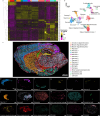Highly sensitive spatial transcriptomics using FISHnCHIPs of multiple co-expressed genes
- PMID: 38491027
- PMCID: PMC10943009
- DOI: 10.1038/s41467-024-46669-y
Highly sensitive spatial transcriptomics using FISHnCHIPs of multiple co-expressed genes
Abstract
High-dimensional, spatially resolved analysis of intact tissue samples promises to transform biomedical research and diagnostics, but existing spatial omics technologies are costly and labor-intensive. We present Fluorescence In Situ Hybridization of Cellular HeterogeneIty and gene expression Programs (FISHnCHIPs) for highly sensitive in situ profiling of cell types and gene expression programs. FISHnCHIPs achieves this by simultaneously imaging ~2-35 co-expressed genes (clustered into modules) that are spatially co-localized in tissues, resulting in similar spatial information as single-gene Fluorescence In Situ Hybridization (FISH), but with ~2-20-fold higher sensitivity. Using FISHnCHIPs, we image up to 53 modules from the mouse kidney and mouse brain, and demonstrate high-speed, large field-of-view profiling of a whole tissue section. FISHnCHIPs also reveals spatially restricted localizations of cancer-associated fibroblasts in a human colorectal cancer biopsy. Overall, FISHnCHIPs enables fast, robust, and scalable cell typing of tissues with normal physiology or undergoing pathogenesis.
© 2024. The Author(s).
Conflict of interest statement
The authors declare the following competing financial interests: The FISHnCHIPs technology described in the manuscript was filed under Singapore Patent Application No. 0202260245V on 29 Nov 22. We are in the process of filing an international PCT. Agency for Science Technology and Research (A*STAR) is the patent applicant and the inventors are K.HC., X.Z., W.Y.S., N.H., J.B., N.C. and J.J.L.G. The remaining authors declare no competing interest.
Figures






Similar articles
-
Spatial transcriptome profiling by MERFISH reveals subcellular RNA compartmentalization and cell cycle-dependent gene expression.Proc Natl Acad Sci U S A. 2019 Sep 24;116(39):19490-19499. doi: 10.1073/pnas.1912459116. Epub 2019 Sep 9. Proc Natl Acad Sci U S A. 2019. PMID: 31501331 Free PMC article.
-
Spatially resolved whole transcriptome profiling in human and mouse tissue using Digital Spatial Profiling.Genome Res. 2022 Oct;32(10):1892-1905. doi: 10.1101/gr.276206.121. Epub 2022 Sep 13. Genome Res. 2022. PMID: 36100434 Free PMC article.
-
Computational solutions for spatial transcriptomics.Comput Struct Biotechnol J. 2022 Sep 1;20:4870-4884. doi: 10.1016/j.csbj.2022.08.043. eCollection 2022. Comput Struct Biotechnol J. 2022. PMID: 36147664 Free PMC article. Review.
-
Scalable in situ single-cell profiling by electrophoretic capture of mRNA using EEL FISH.Nat Biotechnol. 2023 Feb;41(2):222-231. doi: 10.1038/s41587-022-01455-3. Epub 2022 Sep 22. Nat Biotechnol. 2023. PMID: 36138169 Free PMC article.
-
Uncovering an Organ's Molecular Architecture at Single-Cell Resolution by Spatially Resolved Transcriptomics.Trends Biotechnol. 2021 Jan;39(1):43-58. doi: 10.1016/j.tibtech.2020.05.006. Epub 2020 Jun 3. Trends Biotechnol. 2021. PMID: 32505359 Review.
Cited by
-
Next generation lineage tracing and its applications to unravel development.NPJ Syst Biol Appl. 2025 Jun 5;11(1):60. doi: 10.1038/s41540-025-00542-w. NPJ Syst Biol Appl. 2025. PMID: 40473641 Free PMC article. Review.
-
Spatial Single-Cell Mapping of Transcriptional Differences Across Genetic Backgrounds in Mouse Brains.bioRxiv [Preprint]. 2024 Oct 9:2024.10.08.617260. doi: 10.1101/2024.10.08.617260. bioRxiv. 2024. PMID: 39416191 Free PMC article. Preprint.
-
Efficient and highly amplified imaging of nucleic acid targets in cellular and histopathological samples with pSABER.Nat Methods. 2025 Jan;22(1):156-165. doi: 10.1038/s41592-024-02512-2. Epub 2024 Nov 15. Nat Methods. 2025. PMID: 39548245
-
Spatially resolved subcellular protein-protein interactomics in drug-perturbed lung-cancer cultures and tissues.Nat Biomed Eng. 2025 Jul;9(7):1039-1061. doi: 10.1038/s41551-024-01271-x. Epub 2024 Oct 30. Nat Biomed Eng. 2025. PMID: 39478233
References
MeSH terms
Grants and funding
LinkOut - more resources
Full Text Sources
Other Literature Sources

